Addressing Vitamin D Deficiency in Canadian Children: A Report
VerifiedAdded on 2022/11/18
|16
|3512
|249
Report
AI Summary
This report examines the critical issue of vitamin D deficiency in children, particularly within the Canadian context, highlighting the potential risks such as rickets and other health complications. The paper utilizes the Health Promotion Model to advocate for interventions and strategies to address this deficiency. It analyzes the current statistics and demographic data, including the increasing number of children affected by vitamin D deficiency from 1979 to 2018. The report focuses on the lifestyle/behavioral and socio-environmental factors impacting vitamin D status, such as limited sun exposure and dietary inadequacies. It also discusses how the Population Health Promotion Model can guide the development of effective interventions to improve children's health outcomes. The report emphasizes the need for community-based programs, healthcare integration, and policy changes to ensure children have access to sufficient vitamin D, promoting bone health and overall well-being. The findings underscore the importance of addressing various health determinants, including behavioral and socio-demographic factors, to improve the health of the younger population in Canada and prevent vitamin D deficiency related disorders.

HEALTHCARE
Assignment 3
Name
Professor
Course
Date
Assignment 3
Name
Professor
Course
Date
Paraphrase This Document
Need a fresh take? Get an instant paraphrase of this document with our AI Paraphraser

HEALTHCARE
Abstract
Abbasian et al, (2016) cited that health is an essential aspect that ensures there is a better living
within society. The author elaborates on how a healthy person is more productive. The entire
paper encapsulates the discussion on children lacking vitamin D. To handle these challenges on
children, the whole report will account for the use of the Health Promotion Model. The approach
demands healthcare units to integrate relevant virtues, which will advocate for better health.
Lacking the policies and mechanisms for handlings aspect of vitamin D, it will be difficult for
children to have better lives. Therefore, the healthcare centers ought to incorporate various
elements to their core concepts to handle challenges resulting from a lack of vitamin D in
children. The use Health Promotion Model in this paper will guide on how to apply appropriate
procedures that will facilitate the formation of a healthy society more so the children.
Introduction
According to Alrefai et al., (2017), there is enough evidence that vitamin D is missing in Canada.
The current statistics indicate that most of the children in Canada are under threats of rickets due
to lack of vitamin D. ,,,,cited that vitamin D is one of the fundamental components that is needed
by the body. The vitamin is useful in strengthening bones and teeth in human beings. The
deficiency of vitamin D forces children to grow with some challenges such as rickets, among
others. The use of Health Promotion tool in Canada can be the best approach for advocating the
need for vitamin D. Brett et al., (2015) argued that the human body could not work without the
help of vitamins. The children in Canada are under threat of developing some adverse conditions
which are caused by the deficiency of vitamin D. Most of the researchers have advocated for the
issue of a community-based program aiming to create awareness on the deficiency of vitamin S
Abstract
Abbasian et al, (2016) cited that health is an essential aspect that ensures there is a better living
within society. The author elaborates on how a healthy person is more productive. The entire
paper encapsulates the discussion on children lacking vitamin D. To handle these challenges on
children, the whole report will account for the use of the Health Promotion Model. The approach
demands healthcare units to integrate relevant virtues, which will advocate for better health.
Lacking the policies and mechanisms for handlings aspect of vitamin D, it will be difficult for
children to have better lives. Therefore, the healthcare centers ought to incorporate various
elements to their core concepts to handle challenges resulting from a lack of vitamin D in
children. The use Health Promotion Model in this paper will guide on how to apply appropriate
procedures that will facilitate the formation of a healthy society more so the children.
Introduction
According to Alrefai et al., (2017), there is enough evidence that vitamin D is missing in Canada.
The current statistics indicate that most of the children in Canada are under threats of rickets due
to lack of vitamin D. ,,,,cited that vitamin D is one of the fundamental components that is needed
by the body. The vitamin is useful in strengthening bones and teeth in human beings. The
deficiency of vitamin D forces children to grow with some challenges such as rickets, among
others. The use of Health Promotion tool in Canada can be the best approach for advocating the
need for vitamin D. Brett et al., (2015) argued that the human body could not work without the
help of vitamins. The children in Canada are under threat of developing some adverse conditions
which are caused by the deficiency of vitamin D. Most of the researchers have advocated for the
issue of a community-based program aiming to create awareness on the deficiency of vitamin S
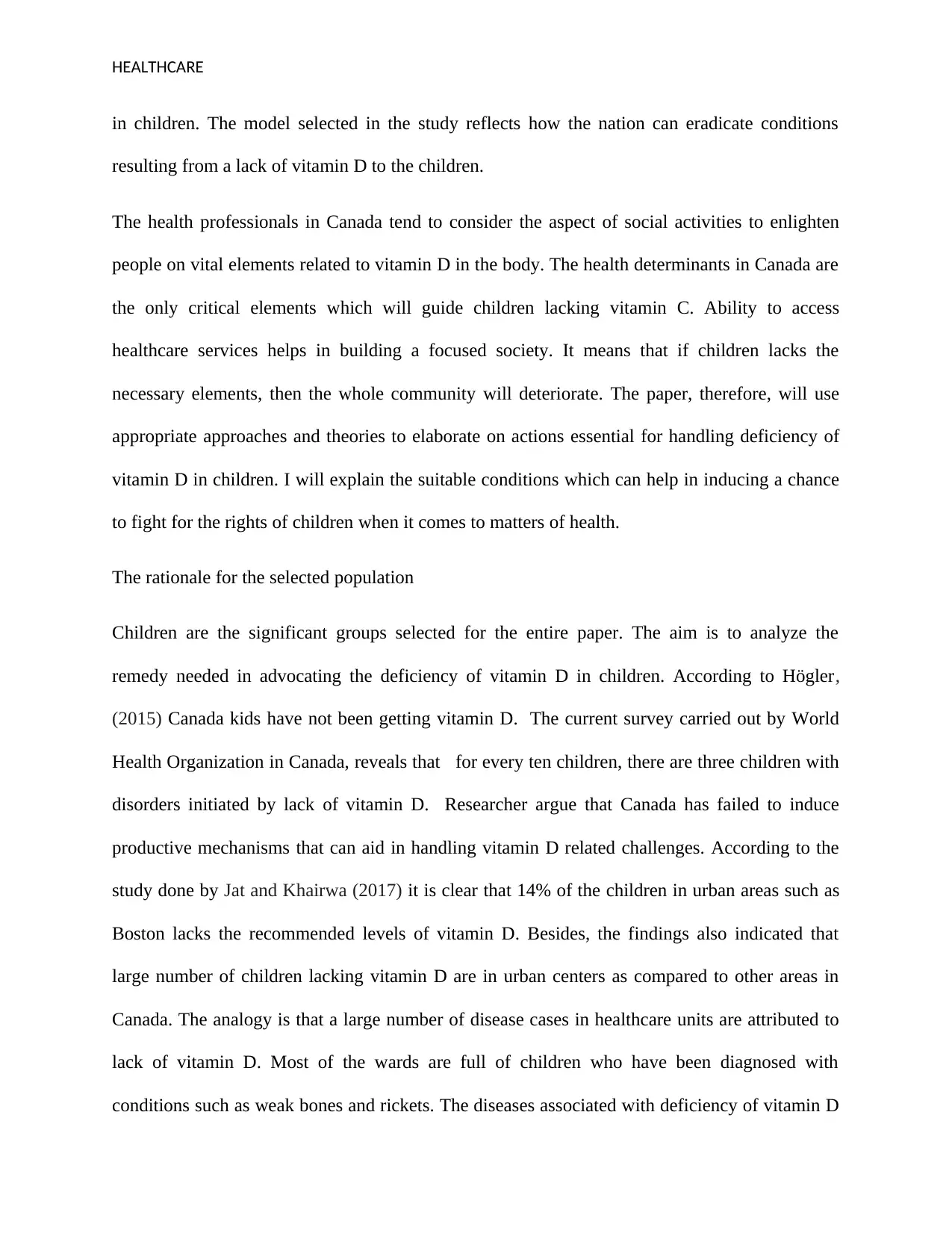
HEALTHCARE
in children. The model selected in the study reflects how the nation can eradicate conditions
resulting from a lack of vitamin D to the children.
The health professionals in Canada tend to consider the aspect of social activities to enlighten
people on vital elements related to vitamin D in the body. The health determinants in Canada are
the only critical elements which will guide children lacking vitamin C. Ability to access
healthcare services helps in building a focused society. It means that if children lacks the
necessary elements, then the whole community will deteriorate. The paper, therefore, will use
appropriate approaches and theories to elaborate on actions essential for handling deficiency of
vitamin D in children. I will explain the suitable conditions which can help in inducing a chance
to fight for the rights of children when it comes to matters of health.
The rationale for the selected population
Children are the significant groups selected for the entire paper. The aim is to analyze the
remedy needed in advocating the deficiency of vitamin D in children. According to Högler,
(2015) Canada kids have not been getting vitamin D. The current survey carried out by World
Health Organization in Canada, reveals that for every ten children, there are three children with
disorders initiated by lack of vitamin D. Researcher argue that Canada has failed to induce
productive mechanisms that can aid in handling vitamin D related challenges. According to the
study done by Jat and Khairwa (2017) it is clear that 14% of the children in urban areas such as
Boston lacks the recommended levels of vitamin D. Besides, the findings also indicated that
large number of children lacking vitamin D are in urban centers as compared to other areas in
Canada. The analogy is that a large number of disease cases in healthcare units are attributed to
lack of vitamin D. Most of the wards are full of children who have been diagnosed with
conditions such as weak bones and rickets. The diseases associated with deficiency of vitamin D
in children. The model selected in the study reflects how the nation can eradicate conditions
resulting from a lack of vitamin D to the children.
The health professionals in Canada tend to consider the aspect of social activities to enlighten
people on vital elements related to vitamin D in the body. The health determinants in Canada are
the only critical elements which will guide children lacking vitamin C. Ability to access
healthcare services helps in building a focused society. It means that if children lacks the
necessary elements, then the whole community will deteriorate. The paper, therefore, will use
appropriate approaches and theories to elaborate on actions essential for handling deficiency of
vitamin D in children. I will explain the suitable conditions which can help in inducing a chance
to fight for the rights of children when it comes to matters of health.
The rationale for the selected population
Children are the significant groups selected for the entire paper. The aim is to analyze the
remedy needed in advocating the deficiency of vitamin D in children. According to Högler,
(2015) Canada kids have not been getting vitamin D. The current survey carried out by World
Health Organization in Canada, reveals that for every ten children, there are three children with
disorders initiated by lack of vitamin D. Researcher argue that Canada has failed to induce
productive mechanisms that can aid in handling vitamin D related challenges. According to the
study done by Jat and Khairwa (2017) it is clear that 14% of the children in urban areas such as
Boston lacks the recommended levels of vitamin D. Besides, the findings also indicated that
large number of children lacking vitamin D are in urban centers as compared to other areas in
Canada. The analogy is that a large number of disease cases in healthcare units are attributed to
lack of vitamin D. Most of the wards are full of children who have been diagnosed with
conditions such as weak bones and rickets. The diseases associated with deficiency of vitamin D
⊘ This is a preview!⊘
Do you want full access?
Subscribe today to unlock all pages.

Trusted by 1+ million students worldwide
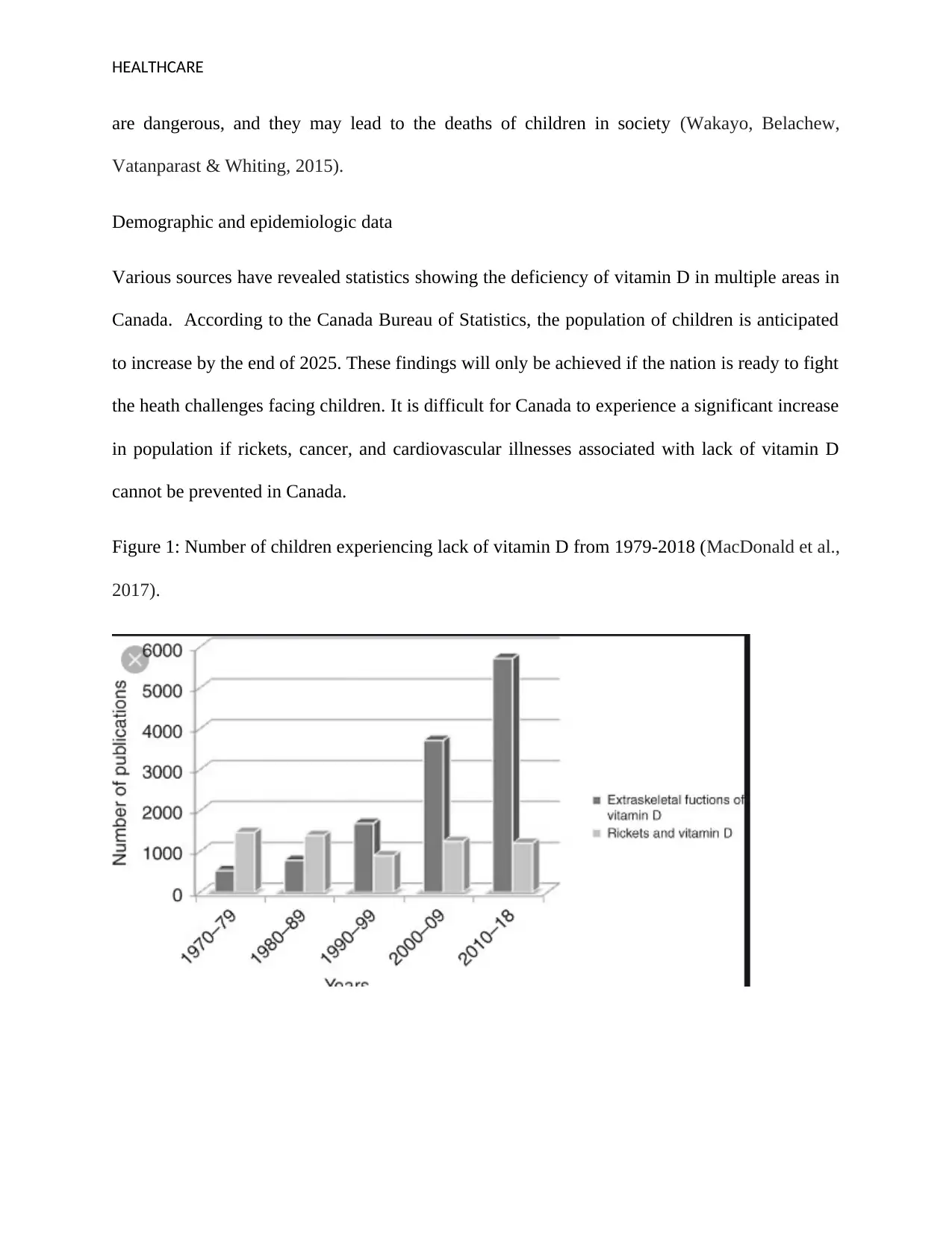
HEALTHCARE
are dangerous, and they may lead to the deaths of children in society (Wakayo, Belachew,
Vatanparast & Whiting, 2015).
Demographic and epidemiologic data
Various sources have revealed statistics showing the deficiency of vitamin D in multiple areas in
Canada. According to the Canada Bureau of Statistics, the population of children is anticipated
to increase by the end of 2025. These findings will only be achieved if the nation is ready to fight
the heath challenges facing children. It is difficult for Canada to experience a significant increase
in population if rickets, cancer, and cardiovascular illnesses associated with lack of vitamin D
cannot be prevented in Canada.
Figure 1: Number of children experiencing lack of vitamin D from 1979-2018 (MacDonald et al.,
2017).
are dangerous, and they may lead to the deaths of children in society (Wakayo, Belachew,
Vatanparast & Whiting, 2015).
Demographic and epidemiologic data
Various sources have revealed statistics showing the deficiency of vitamin D in multiple areas in
Canada. According to the Canada Bureau of Statistics, the population of children is anticipated
to increase by the end of 2025. These findings will only be achieved if the nation is ready to fight
the heath challenges facing children. It is difficult for Canada to experience a significant increase
in population if rickets, cancer, and cardiovascular illnesses associated with lack of vitamin D
cannot be prevented in Canada.
Figure 1: Number of children experiencing lack of vitamin D from 1979-2018 (MacDonald et al.,
2017).
Paraphrase This Document
Need a fresh take? Get an instant paraphrase of this document with our AI Paraphraser
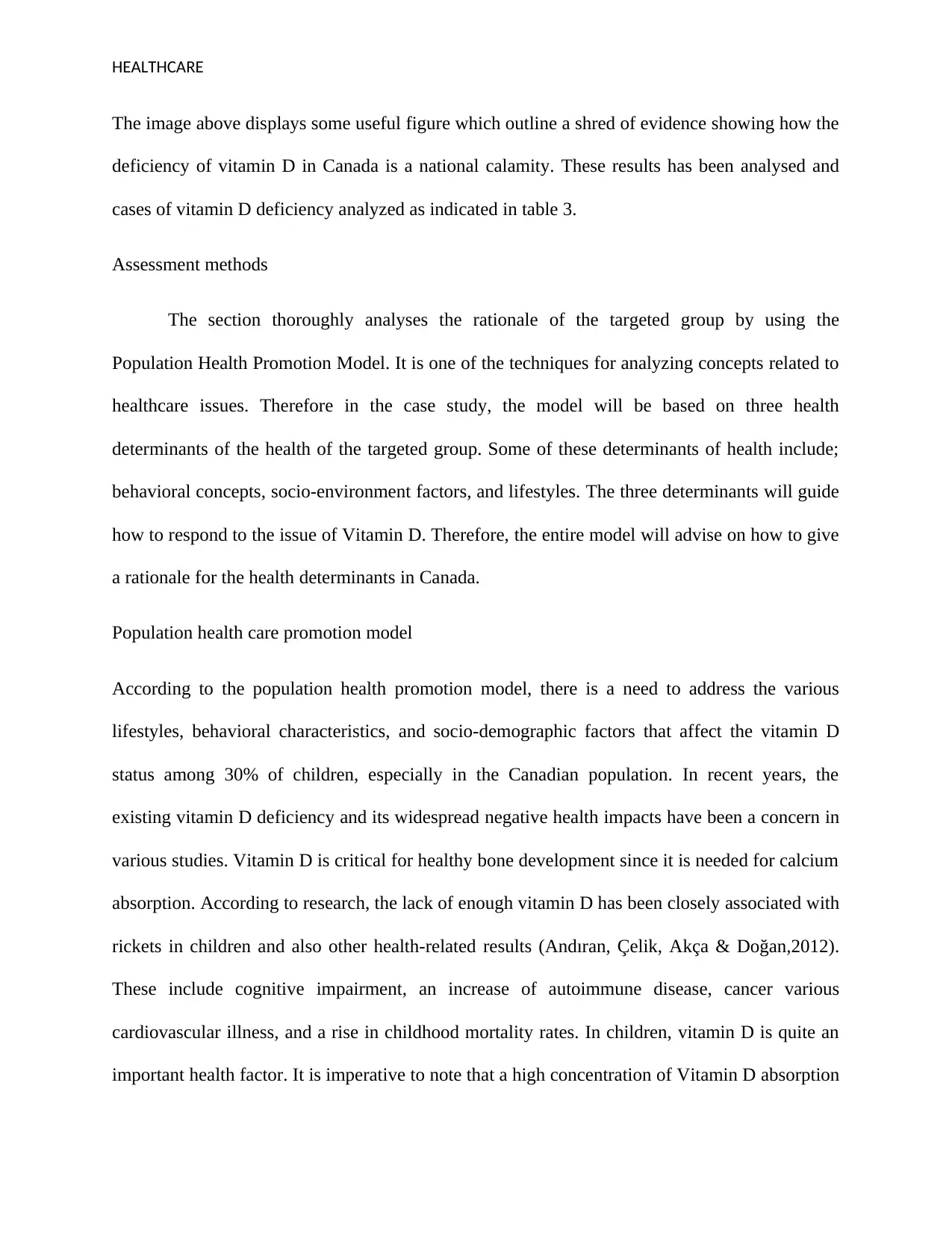
HEALTHCARE
The image above displays some useful figure which outline a shred of evidence showing how the
deficiency of vitamin D in Canada is a national calamity. These results has been analysed and
cases of vitamin D deficiency analyzed as indicated in table 3.
Assessment methods
The section thoroughly analyses the rationale of the targeted group by using the
Population Health Promotion Model. It is one of the techniques for analyzing concepts related to
healthcare issues. Therefore in the case study, the model will be based on three health
determinants of the health of the targeted group. Some of these determinants of health include;
behavioral concepts, socio-environment factors, and lifestyles. The three determinants will guide
how to respond to the issue of Vitamin D. Therefore, the entire model will advise on how to give
a rationale for the health determinants in Canada.
Population health care promotion model
According to the population health promotion model, there is a need to address the various
lifestyles, behavioral characteristics, and socio-demographic factors that affect the vitamin D
status among 30% of children, especially in the Canadian population. In recent years, the
existing vitamin D deficiency and its widespread negative health impacts have been a concern in
various studies. Vitamin D is critical for healthy bone development since it is needed for calcium
absorption. According to research, the lack of enough vitamin D has been closely associated with
rickets in children and also other health-related results (Andıran, Çelik, Akça & Doğan,2012).
These include cognitive impairment, an increase of autoimmune disease, cancer various
cardiovascular illness, and a rise in childhood mortality rates. In children, vitamin D is quite an
important health factor. It is imperative to note that a high concentration of Vitamin D absorption
The image above displays some useful figure which outline a shred of evidence showing how the
deficiency of vitamin D in Canada is a national calamity. These results has been analysed and
cases of vitamin D deficiency analyzed as indicated in table 3.
Assessment methods
The section thoroughly analyses the rationale of the targeted group by using the
Population Health Promotion Model. It is one of the techniques for analyzing concepts related to
healthcare issues. Therefore in the case study, the model will be based on three health
determinants of the health of the targeted group. Some of these determinants of health include;
behavioral concepts, socio-environment factors, and lifestyles. The three determinants will guide
how to respond to the issue of Vitamin D. Therefore, the entire model will advise on how to give
a rationale for the health determinants in Canada.
Population health care promotion model
According to the population health promotion model, there is a need to address the various
lifestyles, behavioral characteristics, and socio-demographic factors that affect the vitamin D
status among 30% of children, especially in the Canadian population. In recent years, the
existing vitamin D deficiency and its widespread negative health impacts have been a concern in
various studies. Vitamin D is critical for healthy bone development since it is needed for calcium
absorption. According to research, the lack of enough vitamin D has been closely associated with
rickets in children and also other health-related results (Andıran, Çelik, Akça & Doğan,2012).
These include cognitive impairment, an increase of autoimmune disease, cancer various
cardiovascular illness, and a rise in childhood mortality rates. In children, vitamin D is quite an
important health factor. It is imperative to note that a high concentration of Vitamin D absorption
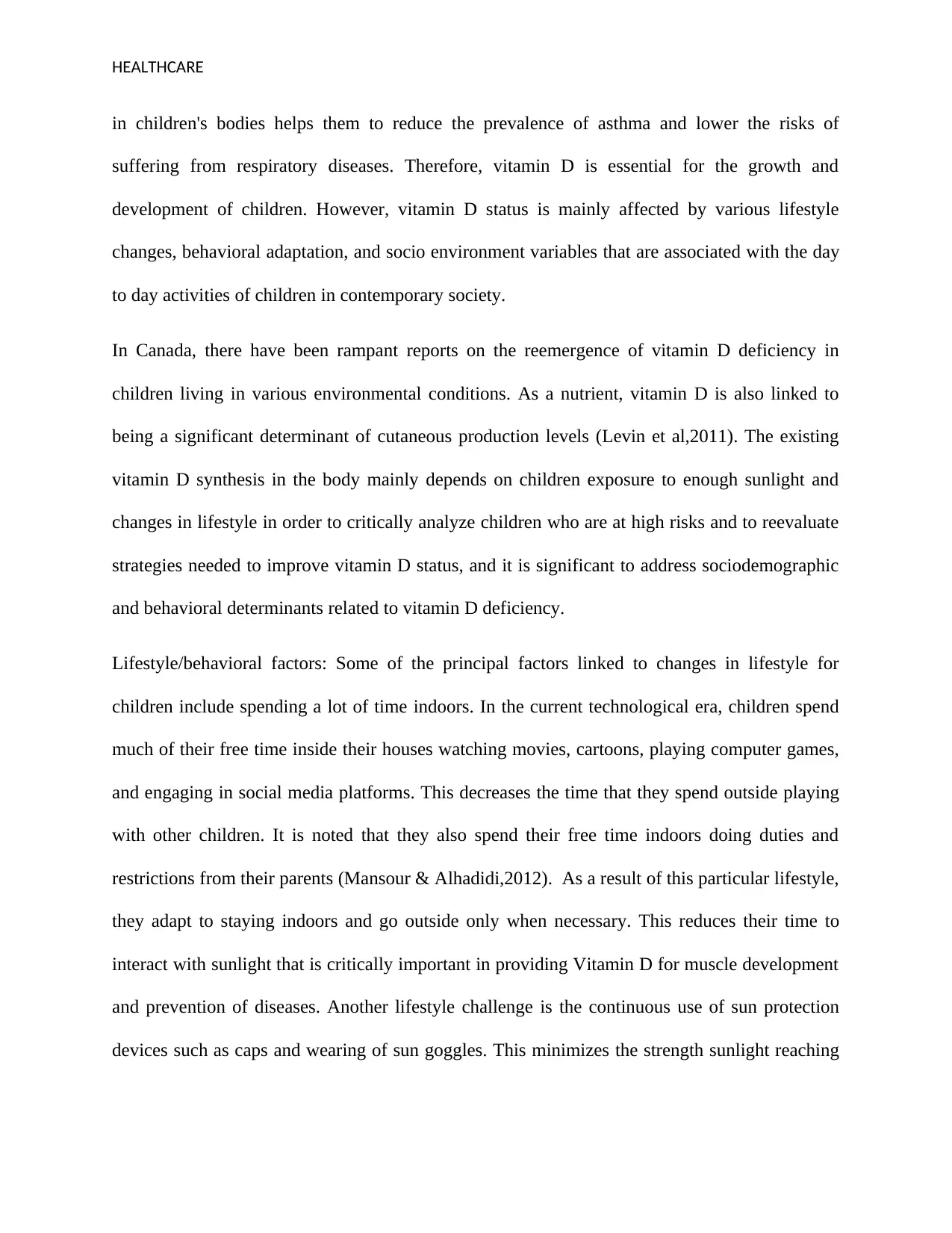
HEALTHCARE
in children's bodies helps them to reduce the prevalence of asthma and lower the risks of
suffering from respiratory diseases. Therefore, vitamin D is essential for the growth and
development of children. However, vitamin D status is mainly affected by various lifestyle
changes, behavioral adaptation, and socio environment variables that are associated with the day
to day activities of children in contemporary society.
In Canada, there have been rampant reports on the reemergence of vitamin D deficiency in
children living in various environmental conditions. As a nutrient, vitamin D is also linked to
being a significant determinant of cutaneous production levels (Levin et al,2011). The existing
vitamin D synthesis in the body mainly depends on children exposure to enough sunlight and
changes in lifestyle in order to critically analyze children who are at high risks and to reevaluate
strategies needed to improve vitamin D status, and it is significant to address sociodemographic
and behavioral determinants related to vitamin D deficiency.
Lifestyle/behavioral factors: Some of the principal factors linked to changes in lifestyle for
children include spending a lot of time indoors. In the current technological era, children spend
much of their free time inside their houses watching movies, cartoons, playing computer games,
and engaging in social media platforms. This decreases the time that they spend outside playing
with other children. It is noted that they also spend their free time indoors doing duties and
restrictions from their parents (Mansour & Alhadidi,2012). As a result of this particular lifestyle,
they adapt to staying indoors and go outside only when necessary. This reduces their time to
interact with sunlight that is critically important in providing Vitamin D for muscle development
and prevention of diseases. Another lifestyle challenge is the continuous use of sun protection
devices such as caps and wearing of sun goggles. This minimizes the strength sunlight reaching
in children's bodies helps them to reduce the prevalence of asthma and lower the risks of
suffering from respiratory diseases. Therefore, vitamin D is essential for the growth and
development of children. However, vitamin D status is mainly affected by various lifestyle
changes, behavioral adaptation, and socio environment variables that are associated with the day
to day activities of children in contemporary society.
In Canada, there have been rampant reports on the reemergence of vitamin D deficiency in
children living in various environmental conditions. As a nutrient, vitamin D is also linked to
being a significant determinant of cutaneous production levels (Levin et al,2011). The existing
vitamin D synthesis in the body mainly depends on children exposure to enough sunlight and
changes in lifestyle in order to critically analyze children who are at high risks and to reevaluate
strategies needed to improve vitamin D status, and it is significant to address sociodemographic
and behavioral determinants related to vitamin D deficiency.
Lifestyle/behavioral factors: Some of the principal factors linked to changes in lifestyle for
children include spending a lot of time indoors. In the current technological era, children spend
much of their free time inside their houses watching movies, cartoons, playing computer games,
and engaging in social media platforms. This decreases the time that they spend outside playing
with other children. It is noted that they also spend their free time indoors doing duties and
restrictions from their parents (Mansour & Alhadidi,2012). As a result of this particular lifestyle,
they adapt to staying indoors and go outside only when necessary. This reduces their time to
interact with sunlight that is critically important in providing Vitamin D for muscle development
and prevention of diseases. Another lifestyle challenge is the continuous use of sun protection
devices such as caps and wearing of sun goggles. This minimizes the strength sunlight reaching
⊘ This is a preview!⊘
Do you want full access?
Subscribe today to unlock all pages.

Trusted by 1+ million students worldwide
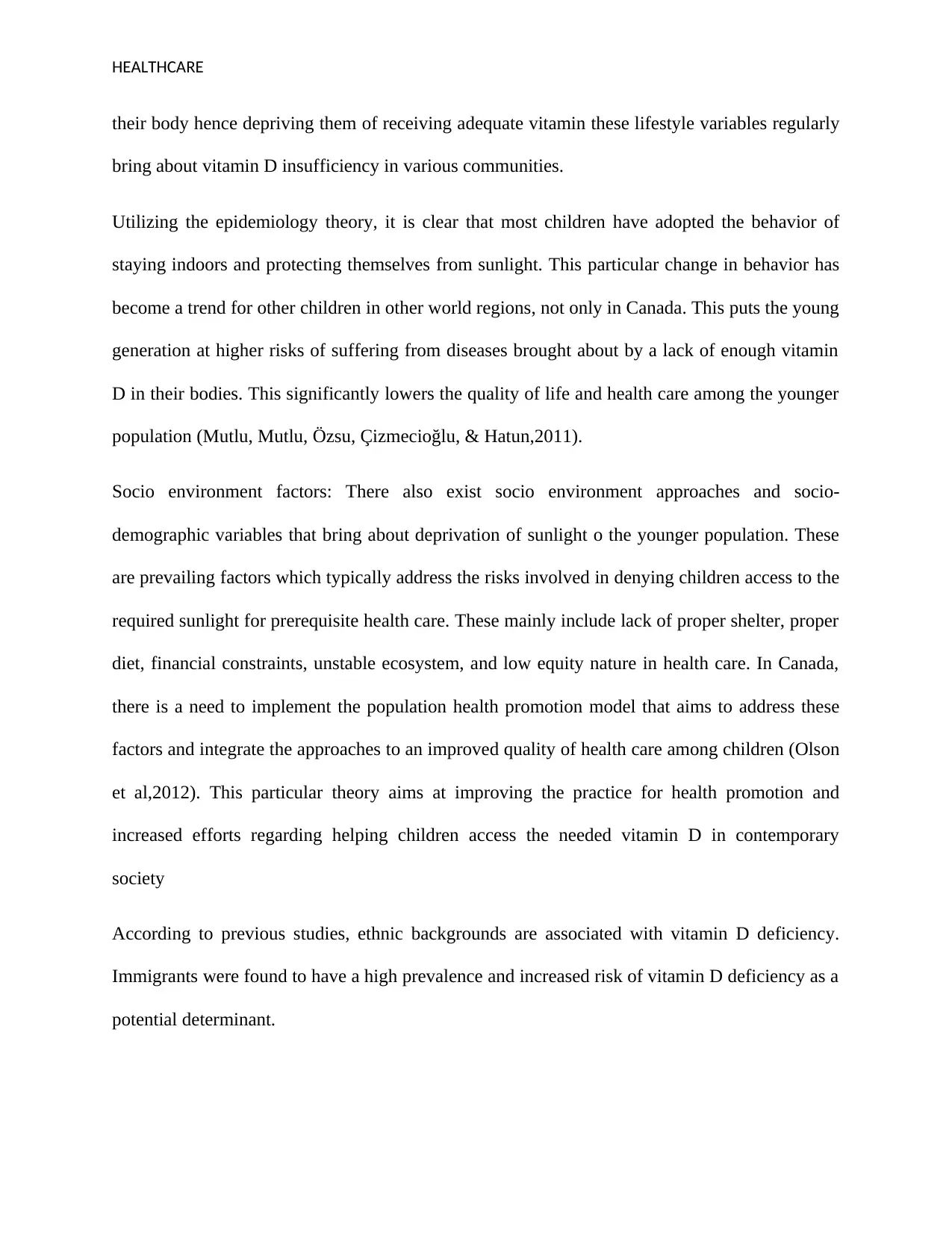
HEALTHCARE
their body hence depriving them of receiving adequate vitamin these lifestyle variables regularly
bring about vitamin D insufficiency in various communities.
Utilizing the epidemiology theory, it is clear that most children have adopted the behavior of
staying indoors and protecting themselves from sunlight. This particular change in behavior has
become a trend for other children in other world regions, not only in Canada. This puts the young
generation at higher risks of suffering from diseases brought about by a lack of enough vitamin
D in their bodies. This significantly lowers the quality of life and health care among the younger
population (Mutlu, Mutlu, Özsu, Çizmecioğlu, & Hatun,2011).
Socio environment factors: There also exist socio environment approaches and socio-
demographic variables that bring about deprivation of sunlight o the younger population. These
are prevailing factors which typically address the risks involved in denying children access to the
required sunlight for prerequisite health care. These mainly include lack of proper shelter, proper
diet, financial constraints, unstable ecosystem, and low equity nature in health care. In Canada,
there is a need to implement the population health promotion model that aims to address these
factors and integrate the approaches to an improved quality of health care among children (Olson
et al,2012). This particular theory aims at improving the practice for health promotion and
increased efforts regarding helping children access the needed vitamin D in contemporary
society
According to previous studies, ethnic backgrounds are associated with vitamin D deficiency.
Immigrants were found to have a high prevalence and increased risk of vitamin D deficiency as a
potential determinant.
their body hence depriving them of receiving adequate vitamin these lifestyle variables regularly
bring about vitamin D insufficiency in various communities.
Utilizing the epidemiology theory, it is clear that most children have adopted the behavior of
staying indoors and protecting themselves from sunlight. This particular change in behavior has
become a trend for other children in other world regions, not only in Canada. This puts the young
generation at higher risks of suffering from diseases brought about by a lack of enough vitamin
D in their bodies. This significantly lowers the quality of life and health care among the younger
population (Mutlu, Mutlu, Özsu, Çizmecioğlu, & Hatun,2011).
Socio environment factors: There also exist socio environment approaches and socio-
demographic variables that bring about deprivation of sunlight o the younger population. These
are prevailing factors which typically address the risks involved in denying children access to the
required sunlight for prerequisite health care. These mainly include lack of proper shelter, proper
diet, financial constraints, unstable ecosystem, and low equity nature in health care. In Canada,
there is a need to implement the population health promotion model that aims to address these
factors and integrate the approaches to an improved quality of health care among children (Olson
et al,2012). This particular theory aims at improving the practice for health promotion and
increased efforts regarding helping children access the needed vitamin D in contemporary
society
According to previous studies, ethnic backgrounds are associated with vitamin D deficiency.
Immigrants were found to have a high prevalence and increased risk of vitamin D deficiency as a
potential determinant.
Paraphrase This Document
Need a fresh take? Get an instant paraphrase of this document with our AI Paraphraser
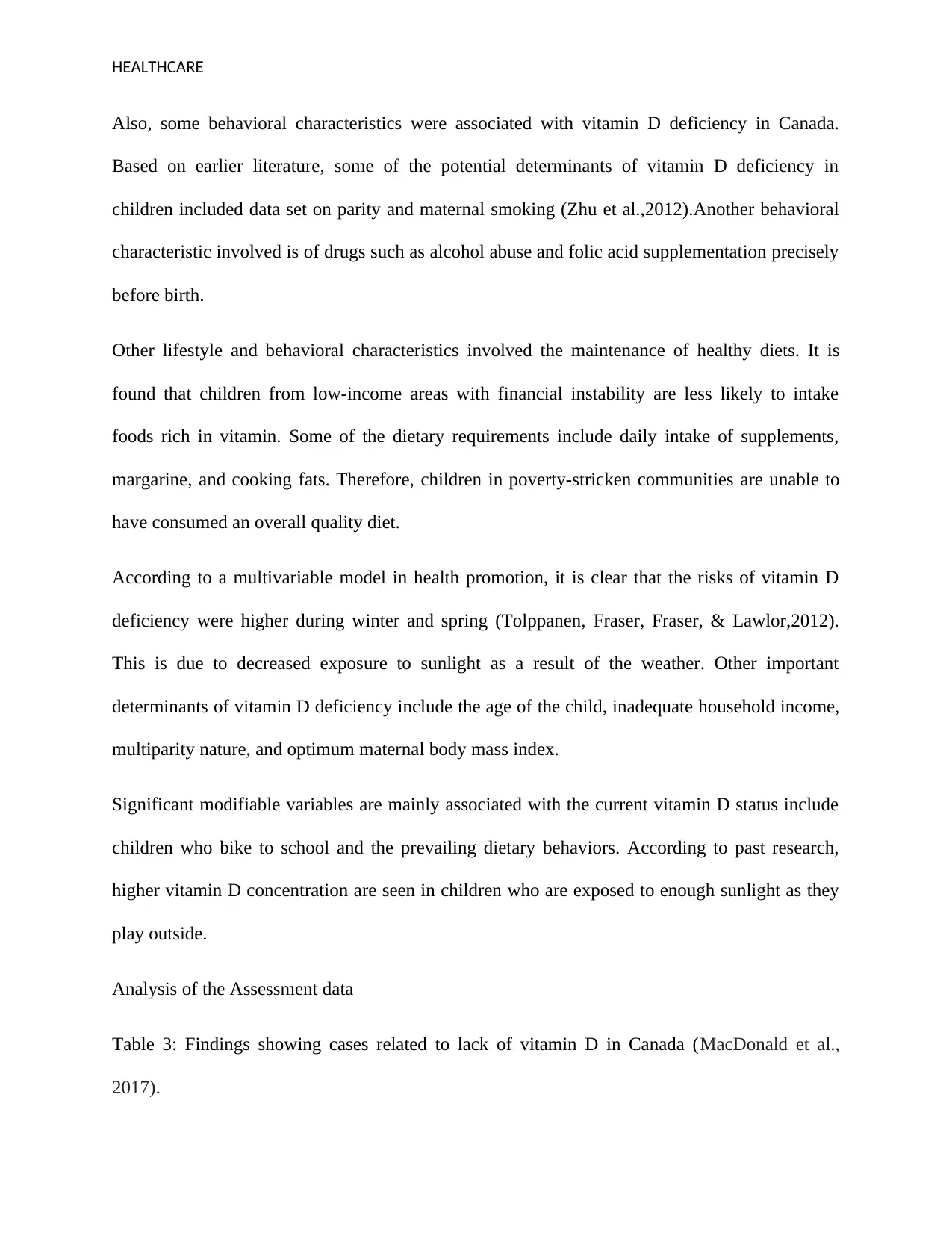
HEALTHCARE
Also, some behavioral characteristics were associated with vitamin D deficiency in Canada.
Based on earlier literature, some of the potential determinants of vitamin D deficiency in
children included data set on parity and maternal smoking (Zhu et al.,2012).Another behavioral
characteristic involved is of drugs such as alcohol abuse and folic acid supplementation precisely
before birth.
Other lifestyle and behavioral characteristics involved the maintenance of healthy diets. It is
found that children from low-income areas with financial instability are less likely to intake
foods rich in vitamin. Some of the dietary requirements include daily intake of supplements,
margarine, and cooking fats. Therefore, children in poverty-stricken communities are unable to
have consumed an overall quality diet.
According to a multivariable model in health promotion, it is clear that the risks of vitamin D
deficiency were higher during winter and spring (Tolppanen, Fraser, Fraser, & Lawlor,2012).
This is due to decreased exposure to sunlight as a result of the weather. Other important
determinants of vitamin D deficiency include the age of the child, inadequate household income,
multiparity nature, and optimum maternal body mass index.
Significant modifiable variables are mainly associated with the current vitamin D status include
children who bike to school and the prevailing dietary behaviors. According to past research,
higher vitamin D concentration are seen in children who are exposed to enough sunlight as they
play outside.
Analysis of the Assessment data
Table 3: Findings showing cases related to lack of vitamin D in Canada (MacDonald et al.,
2017).
Also, some behavioral characteristics were associated with vitamin D deficiency in Canada.
Based on earlier literature, some of the potential determinants of vitamin D deficiency in
children included data set on parity and maternal smoking (Zhu et al.,2012).Another behavioral
characteristic involved is of drugs such as alcohol abuse and folic acid supplementation precisely
before birth.
Other lifestyle and behavioral characteristics involved the maintenance of healthy diets. It is
found that children from low-income areas with financial instability are less likely to intake
foods rich in vitamin. Some of the dietary requirements include daily intake of supplements,
margarine, and cooking fats. Therefore, children in poverty-stricken communities are unable to
have consumed an overall quality diet.
According to a multivariable model in health promotion, it is clear that the risks of vitamin D
deficiency were higher during winter and spring (Tolppanen, Fraser, Fraser, & Lawlor,2012).
This is due to decreased exposure to sunlight as a result of the weather. Other important
determinants of vitamin D deficiency include the age of the child, inadequate household income,
multiparity nature, and optimum maternal body mass index.
Significant modifiable variables are mainly associated with the current vitamin D status include
children who bike to school and the prevailing dietary behaviors. According to past research,
higher vitamin D concentration are seen in children who are exposed to enough sunlight as they
play outside.
Analysis of the Assessment data
Table 3: Findings showing cases related to lack of vitamin D in Canada (MacDonald et al.,
2017).
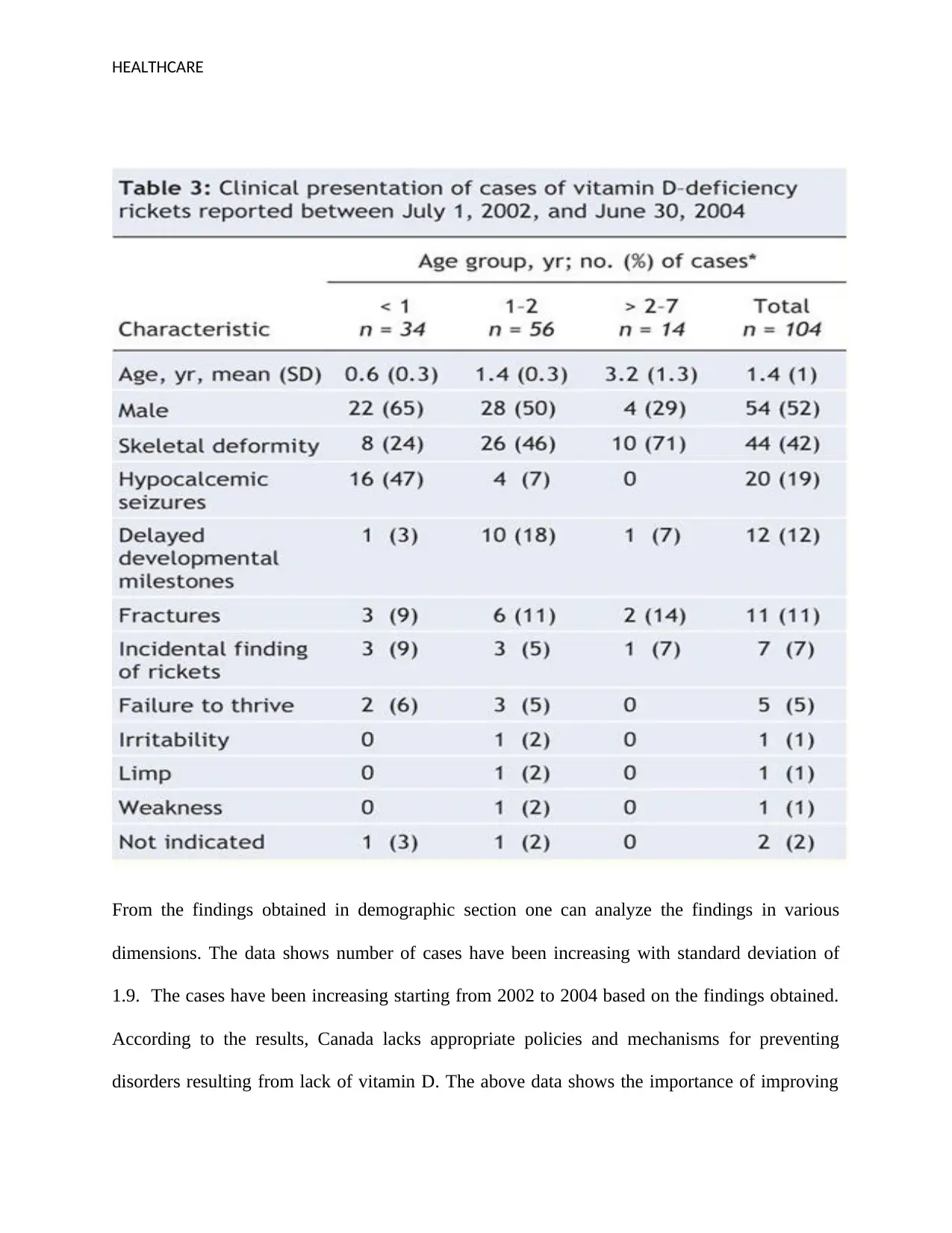
HEALTHCARE
From the findings obtained in demographic section one can analyze the findings in various
dimensions. The data shows number of cases have been increasing with standard deviation of
1.9. The cases have been increasing starting from 2002 to 2004 based on the findings obtained.
According to the results, Canada lacks appropriate policies and mechanisms for preventing
disorders resulting from lack of vitamin D. The above data shows the importance of improving
From the findings obtained in demographic section one can analyze the findings in various
dimensions. The data shows number of cases have been increasing with standard deviation of
1.9. The cases have been increasing starting from 2002 to 2004 based on the findings obtained.
According to the results, Canada lacks appropriate policies and mechanisms for preventing
disorders resulting from lack of vitamin D. The above data shows the importance of improving
⊘ This is a preview!⊘
Do you want full access?
Subscribe today to unlock all pages.

Trusted by 1+ million students worldwide
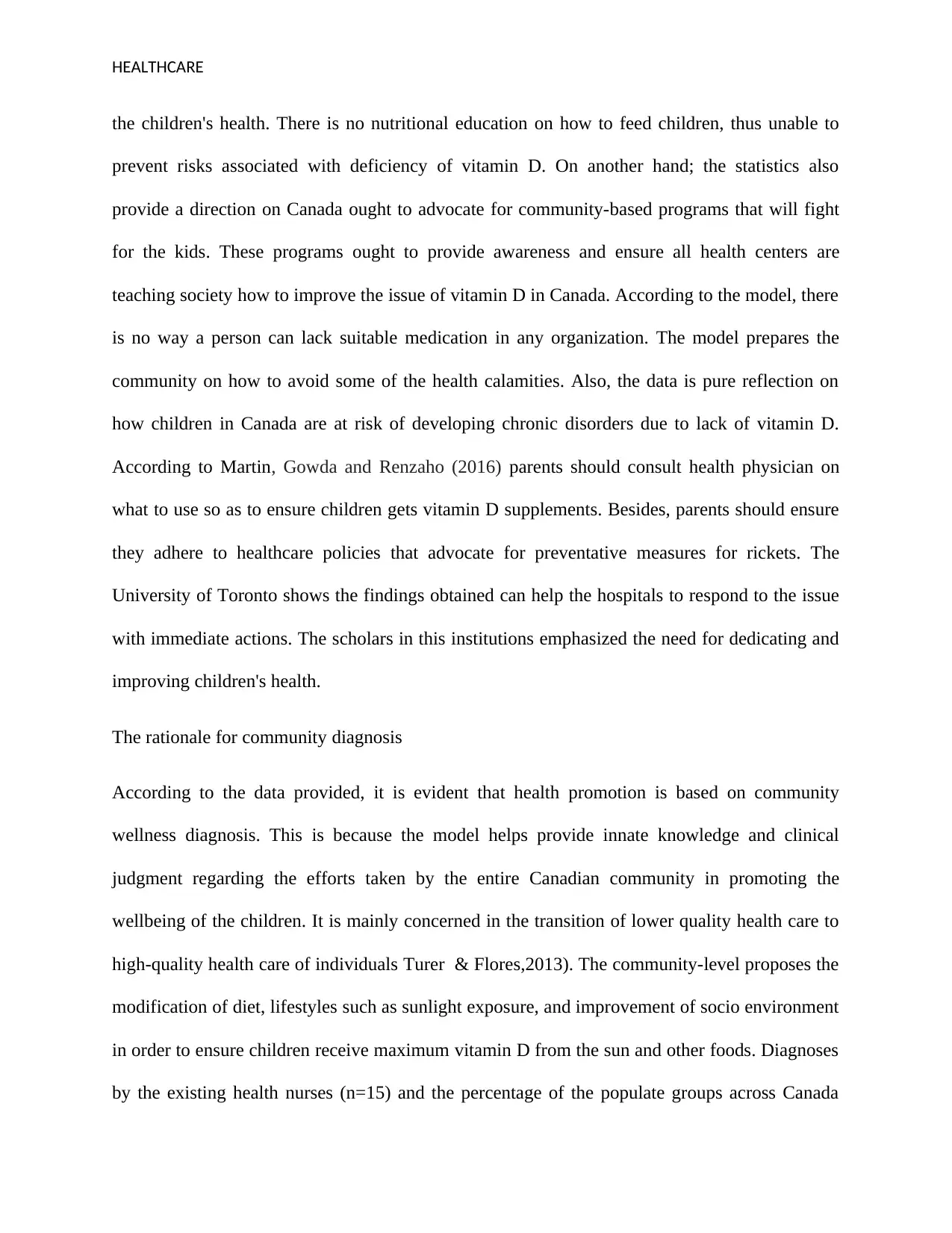
HEALTHCARE
the children's health. There is no nutritional education on how to feed children, thus unable to
prevent risks associated with deficiency of vitamin D. On another hand; the statistics also
provide a direction on Canada ought to advocate for community-based programs that will fight
for the kids. These programs ought to provide awareness and ensure all health centers are
teaching society how to improve the issue of vitamin D in Canada. According to the model, there
is no way a person can lack suitable medication in any organization. The model prepares the
community on how to avoid some of the health calamities. Also, the data is pure reflection on
how children in Canada are at risk of developing chronic disorders due to lack of vitamin D.
According to Martin, Gowda and Renzaho (2016) parents should consult health physician on
what to use so as to ensure children gets vitamin D supplements. Besides, parents should ensure
they adhere to healthcare policies that advocate for preventative measures for rickets. The
University of Toronto shows the findings obtained can help the hospitals to respond to the issue
with immediate actions. The scholars in this institutions emphasized the need for dedicating and
improving children's health.
The rationale for community diagnosis
According to the data provided, it is evident that health promotion is based on community
wellness diagnosis. This is because the model helps provide innate knowledge and clinical
judgment regarding the efforts taken by the entire Canadian community in promoting the
wellbeing of the children. It is mainly concerned in the transition of lower quality health care to
high-quality health care of individuals Turer & Flores,2013). The community-level proposes the
modification of diet, lifestyles such as sunlight exposure, and improvement of socio environment
in order to ensure children receive maximum vitamin D from the sun and other foods. Diagnoses
by the existing health nurses (n=15) and the percentage of the populate groups across Canada
the children's health. There is no nutritional education on how to feed children, thus unable to
prevent risks associated with deficiency of vitamin D. On another hand; the statistics also
provide a direction on Canada ought to advocate for community-based programs that will fight
for the kids. These programs ought to provide awareness and ensure all health centers are
teaching society how to improve the issue of vitamin D in Canada. According to the model, there
is no way a person can lack suitable medication in any organization. The model prepares the
community on how to avoid some of the health calamities. Also, the data is pure reflection on
how children in Canada are at risk of developing chronic disorders due to lack of vitamin D.
According to Martin, Gowda and Renzaho (2016) parents should consult health physician on
what to use so as to ensure children gets vitamin D supplements. Besides, parents should ensure
they adhere to healthcare policies that advocate for preventative measures for rickets. The
University of Toronto shows the findings obtained can help the hospitals to respond to the issue
with immediate actions. The scholars in this institutions emphasized the need for dedicating and
improving children's health.
The rationale for community diagnosis
According to the data provided, it is evident that health promotion is based on community
wellness diagnosis. This is because the model helps provide innate knowledge and clinical
judgment regarding the efforts taken by the entire Canadian community in promoting the
wellbeing of the children. It is mainly concerned in the transition of lower quality health care to
high-quality health care of individuals Turer & Flores,2013). The community-level proposes the
modification of diet, lifestyles such as sunlight exposure, and improvement of socio environment
in order to ensure children receive maximum vitamin D from the sun and other foods. Diagnoses
by the existing health nurses (n=15) and the percentage of the populate groups across Canada
Paraphrase This Document
Need a fresh take? Get an instant paraphrase of this document with our AI Paraphraser
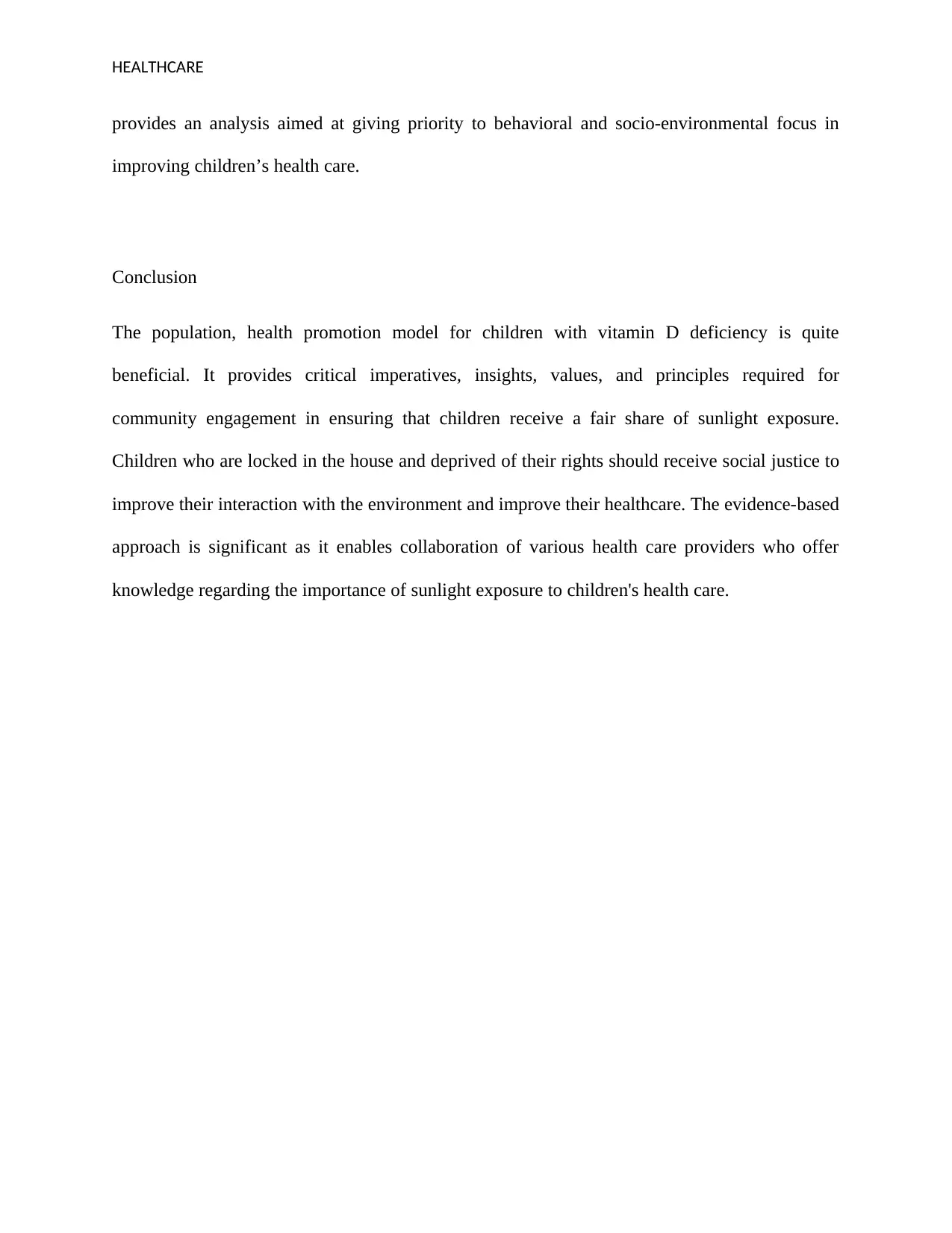
HEALTHCARE
provides an analysis aimed at giving priority to behavioral and socio-environmental focus in
improving children’s health care.
Conclusion
The population, health promotion model for children with vitamin D deficiency is quite
beneficial. It provides critical imperatives, insights, values, and principles required for
community engagement in ensuring that children receive a fair share of sunlight exposure.
Children who are locked in the house and deprived of their rights should receive social justice to
improve their interaction with the environment and improve their healthcare. The evidence-based
approach is significant as it enables collaboration of various health care providers who offer
knowledge regarding the importance of sunlight exposure to children's health care.
provides an analysis aimed at giving priority to behavioral and socio-environmental focus in
improving children’s health care.
Conclusion
The population, health promotion model for children with vitamin D deficiency is quite
beneficial. It provides critical imperatives, insights, values, and principles required for
community engagement in ensuring that children receive a fair share of sunlight exposure.
Children who are locked in the house and deprived of their rights should receive social justice to
improve their interaction with the environment and improve their healthcare. The evidence-based
approach is significant as it enables collaboration of various health care providers who offer
knowledge regarding the importance of sunlight exposure to children's health care.
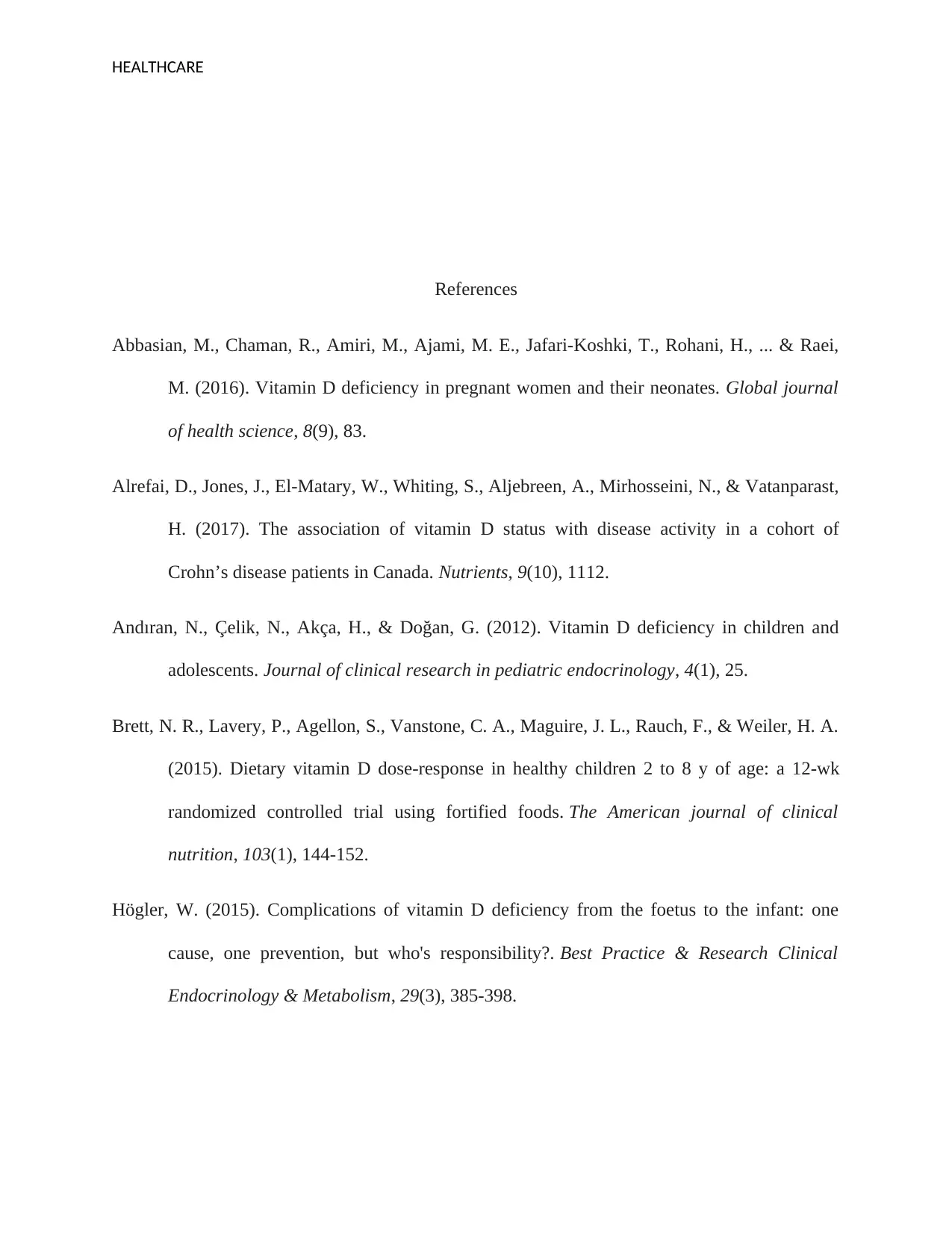
HEALTHCARE
References
Abbasian, M., Chaman, R., Amiri, M., Ajami, M. E., Jafari-Koshki, T., Rohani, H., ... & Raei,
M. (2016). Vitamin D deficiency in pregnant women and their neonates. Global journal
of health science, 8(9), 83.
Alrefai, D., Jones, J., El-Matary, W., Whiting, S., Aljebreen, A., Mirhosseini, N., & Vatanparast,
H. (2017). The association of vitamin D status with disease activity in a cohort of
Crohn’s disease patients in Canada. Nutrients, 9(10), 1112.
Andıran, N., Çelik, N., Akça, H., & Doğan, G. (2012). Vitamin D deficiency in children and
adolescents. Journal of clinical research in pediatric endocrinology, 4(1), 25.
Brett, N. R., Lavery, P., Agellon, S., Vanstone, C. A., Maguire, J. L., Rauch, F., & Weiler, H. A.
(2015). Dietary vitamin D dose-response in healthy children 2 to 8 y of age: a 12-wk
randomized controlled trial using fortified foods. The American journal of clinical
nutrition, 103(1), 144-152.
Högler, W. (2015). Complications of vitamin D deficiency from the foetus to the infant: one
cause, one prevention, but who's responsibility?. Best Practice & Research Clinical
Endocrinology & Metabolism, 29(3), 385-398.
References
Abbasian, M., Chaman, R., Amiri, M., Ajami, M. E., Jafari-Koshki, T., Rohani, H., ... & Raei,
M. (2016). Vitamin D deficiency in pregnant women and their neonates. Global journal
of health science, 8(9), 83.
Alrefai, D., Jones, J., El-Matary, W., Whiting, S., Aljebreen, A., Mirhosseini, N., & Vatanparast,
H. (2017). The association of vitamin D status with disease activity in a cohort of
Crohn’s disease patients in Canada. Nutrients, 9(10), 1112.
Andıran, N., Çelik, N., Akça, H., & Doğan, G. (2012). Vitamin D deficiency in children and
adolescents. Journal of clinical research in pediatric endocrinology, 4(1), 25.
Brett, N. R., Lavery, P., Agellon, S., Vanstone, C. A., Maguire, J. L., Rauch, F., & Weiler, H. A.
(2015). Dietary vitamin D dose-response in healthy children 2 to 8 y of age: a 12-wk
randomized controlled trial using fortified foods. The American journal of clinical
nutrition, 103(1), 144-152.
Högler, W. (2015). Complications of vitamin D deficiency from the foetus to the infant: one
cause, one prevention, but who's responsibility?. Best Practice & Research Clinical
Endocrinology & Metabolism, 29(3), 385-398.
⊘ This is a preview!⊘
Do you want full access?
Subscribe today to unlock all pages.

Trusted by 1+ million students worldwide
1 out of 16
Related Documents
Your All-in-One AI-Powered Toolkit for Academic Success.
+13062052269
info@desklib.com
Available 24*7 on WhatsApp / Email
![[object Object]](/_next/static/media/star-bottom.7253800d.svg)
Unlock your academic potential
Copyright © 2020–2025 A2Z Services. All Rights Reserved. Developed and managed by ZUCOL.





